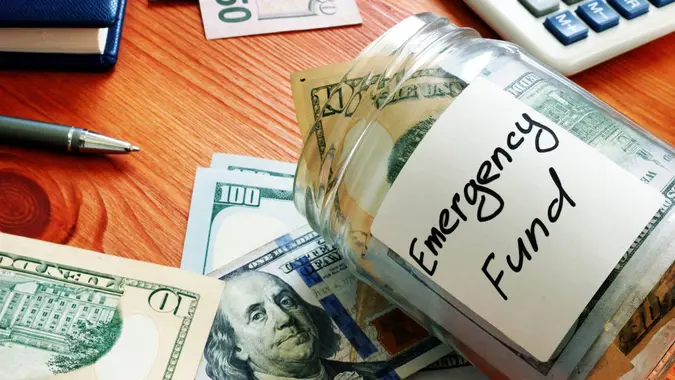Is $10K Enough for an Emergency Fund?

Commitment to Our Readers
GOBankingRates' editorial team is committed to bringing you unbiased reviews and information. We use data-driven methodologies to evaluate financial products and services - our reviews and ratings are not influenced by advertisers. You can read more about our editorial guidelines and our products and services review methodology.

20 Years
Helping You Live Richer

Reviewed
by Experts

Trusted by
Millions of Readers
Deciding if $10,000 is enough for an emergency fund is like choosing the right size of an umbrella – it really depends on how much financial “rain” you expect to encounter. While $10,000 is certainly a respectable amount in savings, whether it’s sufficient for an emergency fund depends on your personal financial situation. Here are some things to consider when you’re on the way to saving $10,000 toward your emergency fund.
Read: Pocket an Extra $400 a Month With This Simple Hack
How Much Do You Actually Need in an Emergency Fund?
The answer may depend on your own financial situation. Think about the following:
- Your financial situation: Whether or not having $10,000 as an emergency fund will depend on your cost of living, income stability and non-negotiable expenses, such as monthly rent or a car payment. For some, it might be more than enough, while for others, it may fall short.
- How long your living expenses cover: Financial experts often recommend saving enough to cover three to six months of living expenses in an emergency fund. The specific target within this range should be based on factors like job security, health considerations, and family responsibilities.
- Short-term investments: You might want to add some short-term investments, such as a high-yield savings account or stocks into an emergency fund. These can enhance your emergency fund’s growth, while still having easy access to your cash–also known as liquidity. The main thing to remember is to keep your emergency fund easy to access and safe, so pick your investments with that in mind.
The Reality of $10K in Savings
For many, hitting the $10,000 mark in savings is a big deal. It means you’ve been diligent and disciplined with your finances. This amount can serve as a cushion for life’s unexpected turns — be it a car breakdown or a sudden medical expense. But the real question is, does this cushion have enough to soften the blow? That’s where individual lifestyles and financial responsibilities come into play.
For example, imagine you suddenly lose your job. Without a steady income, you need to rely on your emergency fund to cover your monthly bills like rent, groceries and utility bills.
Another example–say you’re a homeowner and you’ve got a surprise plumbing accident in your house, which means a costly repair. With a $10,000 emergency fund, you’d have the resources to manage these expenses while you search for a new job, without worrying about where the money’s going to come from.
Consider Your Personal Expenses
Your monthly expenses will ultimately determine if $10,000 is enough. If your living costs are relatively low and you have a stable income, then $10,000 might be more than enough to tide you over in tough times. However, for those living in high-cost areas or with significant financial obligations, $10,000 may only scratch the surface.
Have Some Short-Term Investments
Considering short-term investments as part of your emergency fund can be a smart move. These can include options like high-yield savings accounts or money market funds, which offer easier access and lower risk compared to long-term investments. They can potentially grow your emergency fund faster than a regular savings account, giving you a bit more breathing room financially.
How Many Months Should Your Emergency Fund Cover?
So, how much should you really have tucked away? Financial pros often suggest having enough to cover about three to six months of living expenses. It’s like having a backup plan for your backup plan. If your job situation feels more like riding a rollercoaster, or if you’ve got a family to look after, aiming towards the six-month end might give you more peace of mind. On the flip side, if you’re in a pretty stable job and your expenses are under control, a three-month buffer could do the trick.
Is $10K a Solid Emergency Fund?
Whether $10K is enough for an emergency fund is a personal decision. It depends on your monthly expenses, lifestyle and financial goals. It’s also about finding that sweet spot where you feel secure enough to handle life’s surprises without overextending yourself or your wallet.
FAQ
- Is $10K in savings good?
- Yes, having $10,000 in savings is good. It shows you're making smart financial choices and building a safety net. While the ideal savings amount varies for everyone, $10,000 is a solid foundation and can cover unexpected expenses or emergencies, giving you a sense of security and peace of mind.
- What should I do with my $10K in savings?
- With $10,000 in savings, consider dividing it between an emergency fund and other financial goals you've got in mind. Keep enough to cover three to six months of expenses for emergencies, and use the rest for paying down debt, investing or saving for specific goals like a home or education. Always tailor your strategy to your own needs.
- What happens when your bank account reaches $10K?
- When you've reached $10,000 in savings, you now have a solid cushion for emergencies or future investments. Depending on your bank, you might qualify for better interest rates or premium account benefits. It's also a good time to review your financial goals and consider how to best use this money, whether it's for an emergency fund, investing or saving for a specific goal, such as for travel or a splurge.
Editor's note: This article was produced via automated technology and then fine-tuned and verified for accuracy by a member of GOBankingRates' editorial team.
 Written by
Written by  Edited by
Edited by 

























